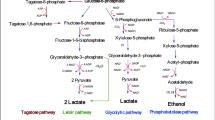Abstract
Megasphaera elsdenii T81 grew on either dl-lactate or d-glucose at similar rates (0.85 h−1) but displayed major differences in the fermentation of these substrates. Lactate was fermented at up to 210-mM concentration to yield acetic, propionic, butyric, and valeric acids. The bacterium was able to grow at much higher concentrations of d-glucose (500 mM), but never removed more than 80 mM of glucose from the medium, and nearly 60 % the glucose removed was sequestered as intracellular glycogen, with low yields of even-carbon acids (acetate, butyrate, caproate). In the presence of both substrates, glucose was not used until lactate was nearly exhausted, even by cells pregrown on glucose. Glucose-grown cultures maintained only low extracellular concentrations of acetate, and addition of exogenous acetate increased yields of butyrate, but not caproate. By contrast, exogenous acetate had little effect on lactate fermentation. At pH 6.6, growth rate was halved by exogenous addition of 60 mM propionate, 69 mM butyrate, 44 mM valerate, or 33 mM caproate; at pH 5.9, these values were reduced to 49, 49, 18, and 22 mM, respectively. The results are consistent with this species’ role as an effective ruminal lactate consumer and suggest that this organism may be useful for industrial production of volatile fatty acids from lactate if product tolerance could be improved. The poor fermentation of glucose and sensitivity to caproate suggests that this strain is not practical for industrial caproate production.





Similar content being viewed by others
References
Bradford MM (1976) A rapid and sensitive method for quantitation of microgram quantities of protein utilizing the principle of protein-dye binding. Anal Biochem 72:248–254
Gutierrez J, Davis RE, Lindahl IL, Warwick EJ (1959) Bacterial changes in the rumen during the onset of feed-lot bloat of cattle and characteristics of Peptostreptococcus elsdenii n. sp. Appl Microbiol 7:16–22
Hall MB (2011) Isotrichid protozoa influence conversion of glucose to glycogen and other microbial products. J Dairy Sci 94:4589–4602
Hino T, Kuroda S (1993) Presence of lactate dehydrogenase and lactate racemase in Megasphaera elsdenii grown on glucose or lactate. Appl Environ Microbiol 59:255–259
Hino T, Miyazaki K, Kuroda S (1991) Role of extracellular acetate in the fermentation of glucose by a ruminal bacterium, Megasphaera elsdenii. J Gen Appl Microbiol 37:121–129
Hino T, Shimada K, Maruyama T (1994) Substrate preference in a strain of Megasphaera elsdenii, a ruminal bacterium, and its implications in propionate production and growth competition. Appl Environ Microbiol 60:1827–1831
Holtzapple M, Granda C (2009) Carboxylate platform: the MixAlco process part 1: comparison of three biomass conversion platforms. Appl Biochem Biotechnol 156:525–536
Kenealy WR, Waselefsky DM (1985) Studies on the substrate range of Clostridium kluyveri: the use of propanol and succinate. Arch Microbiol 141:187–194
Lange JP, Price R, Ayoub PM, Louis J, Petrus L, Clarke L, Gosselink H (2010) Valeric biofuels: a platform of cellulosic transportation fuels. Angew Chem Int Ed 49:4479–4483
Marounek M, Fliegrova K, Bartos S (1989) Metabolism and some characteristics of ruminal strains of Megasphaera elsdenii. Appl Environ Microbiol 55:1570–1573
Meissner HH, Henning PH, Horn CH, Leeuw KL, Hagg FM, Fouche G (2010) Ruminal acidosis: a review with detailed reference to the controlling agent Megasphaera elsdenii NCIMB 41125. S Afr J Anim Sci 40:79–100
Miller GL, Blum R, Glennon WE, Burton AL (1960) Measurement of carboxymethylcellulase activity. Anal Biochem 1:127–132
Pavlostathis SG, Miller TL, Wolin MJ (1988) Fermentation of insoluble cellulose by continuous cultures of Ruminococcus albus. Appl Environ Microbiol 54:2655–2659
Piknová M, Bíres O, Javorsky P, Pristas P (2006) Limited genetic variability in Megasphaera elsdenii strains. Folia Microbiol (Praha) 51:299–302
Rogosa M (1972) Transfer of Peptostreptococcus elsdenii Gutierrez et al. to a new genus, Megasphaera (M. elsdenii (Gutierrez et al.) comb. nov.). Int J Syst Bacteriol 21:187–189
Russell JB, Baldwin LR (1979) Comparison of maintenance energy expenditures and growth yields among several rumen bacteria grown in continuous culture. Appl Environ Microbiol 37:537–543
Russell JB, Hino T (1985) Regulation of lactate production in Streptococcus bovis: a spiraling effect that contributes to rumen acidosis. J Dairy Sci 68:1712–1721
Thauer RK, Jungermann K, Decker K (1977) Energy conservation in chemotrophic anaerobic bacteria. Bacteriol Rev 31:100–180
Torii S, Tanaka H (2001) Carboxylic acids. In: Lund H, Hammerich O (eds) Organic electrochemistry, 4th edn. Marcel Dekker, New York, pp 499–535
Wallace RJ, Chaudhary ME, McKain N, Walker ND (2004) Metabolic properties of Eubacterium pyruvativorans, a ruminal ‘hyper-ammonia-producing’ anaerobe with metabolic properties analogous to those of Clostridium kluyveri. Microbiology 150:2921–2930
Weimer PJ (2010) End product yields from the extraruminal fermentation of various polysaccharide, protein and nucleic acid components of biofuels feedstocks. Biores Technol 012:3254–3259
Weimer PJ, Stevenson DM (2011) Isolation, characterization and quantification of Clostridium kluyveri from the bovine rumen. Appl Microbiol Biotechnol 94:461–466
Weimer PJ, Shi Y, Odt CL (1991) A segmented gas/liquid delivery system for continuous culture of microorganisms on solid substrates, and its use for growth of Ruminococcus flavefaciens on cellulose. Appl Microbiol Biotechnol 36:178–183
Wood WA (1961) Fermentation of carbohydrates and related compounds. In: Gunsalus IC, Stanier RY (eds) The bacteria, vol 2. Academic, New York
Acknowledgments
We thank C.L. Odt for the technical assistance and M.B. Hall for the useful suggestions regarding glycogen analysis. This research was supported by USDA-ARS CRIS project 3655-41000-06-00D.
Conflict of interest
Mention of specific products is for informational purposes only and does not constitute an endorsement or warranty over similar products that may also be suitable.
Author information
Authors and Affiliations
Corresponding author
Rights and permissions
About this article
Cite this article
Weimer, P.J., Moen, G.N. Quantitative analysis of growth and volatile fatty acid production by the anaerobic ruminal bacterium Megasphaera elsdenii T81. Appl Microbiol Biotechnol 97, 4075–4081 (2013). https://doi.org/10.1007/s00253-012-4645-4
Received:
Revised:
Accepted:
Published:
Issue Date:
DOI: https://doi.org/10.1007/s00253-012-4645-4




